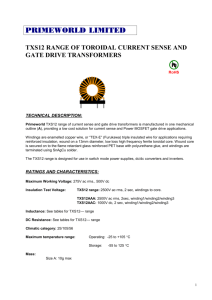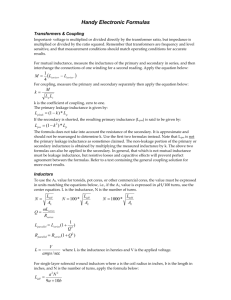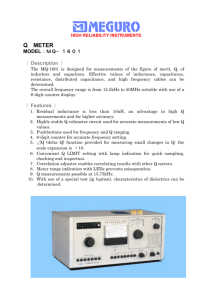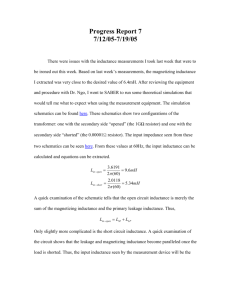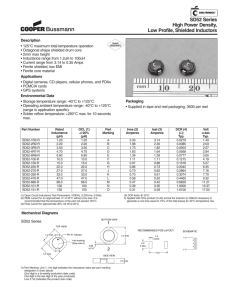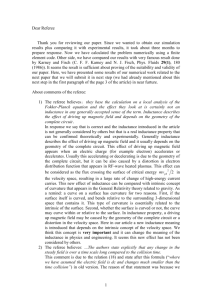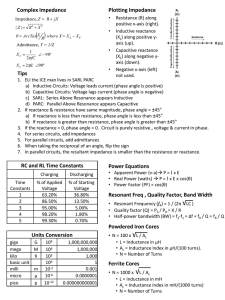PPTX - The Michigan Institute for Plasma Science and Engineering
advertisement
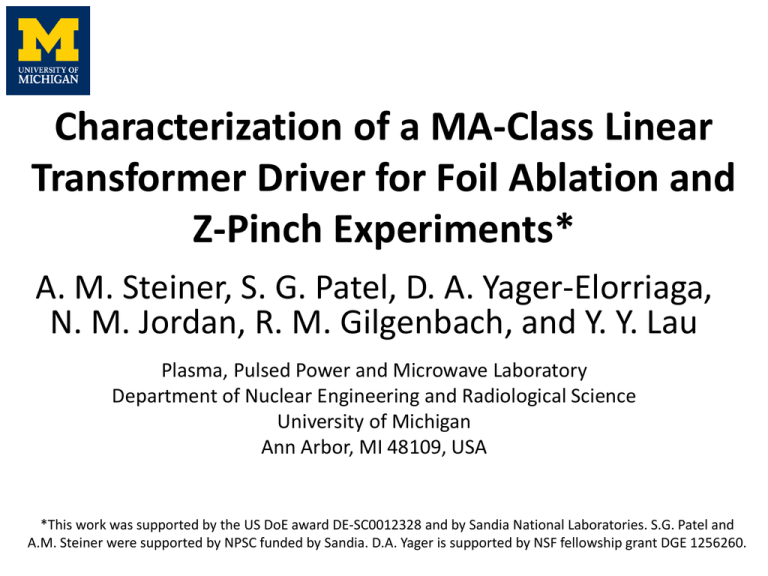
Characterization of a MA-Class Linear Transformer Driver for Foil Ablation and Z-Pinch Experiments* A. M. Steiner, S. G. Patel, D. A. Yager-Elorriaga, N. M. Jordan, R. M. Gilgenbach, and Y. Y. Lau Plasma, Pulsed Power and Microwave Laboratory Department of Nuclear Engineering and Radiological Science University of Michigan Ann Arbor, MI 48109, USA *This work was supported by the US DoE award DE-SC0012328 and by Sandia National Laboratories. S.G. Patel and A.M. Steiner were supported by NPSC funded by Sandia. D.A. Yager is supported by NSF fellowship grant DGE 1256260. Overview • Michigan Accelerator for Inductive Z-Pinch Experiments (MAIZE) 1-MA linear transformer driver (LTD) has been used to drive planar foil1, cylindrical liner2, and wire array ablation3 experiments • Current experiments on MAIZE include electrothermal instability growth rate measurements4 and thin imploding liner physics2 • MAIZE consists of a capacitor section, nonuniform vacuum transmission line, and load • A full LTD model accounting for reactive and resistive loads has been developed to make current and voltage predictions as a function of load; model has been verified against experimental data 1) 2) 3) 4) Zier et al., Phys. of Plasmas (2012) Yager-Elorriaga et al., ICOPS (2015) Safronova et al., APS-DPP (2014) Steiner et al., APS-DPP (2014) Motivation • Single-stage LTDs like MAIZE have very low generator-side impedance; Load impedance (both reactive and resistive) determines peak current, risetime, etc. • Designing experiments often requires predictive capability for voltage and current output – Predict peak current and risetime – Evaluate insulator stress – Diagnose losses – Determine if magnetic insulation is achieved MAIZE LTD Specifications Oil cavity of MAIZE with top lid removed to show capacitor-switch bricks MAIZE LTD Diagram G A B C D E F H I A: Spark gap switch B: Capacitor C: Iron Core section D: Coaxial Transmission line E: Radial transmission line F: Load hardware (shown with triplate transmission line adapter G: Vacuum Chamber (light blue and gray) H: Oil chamber (dark blue) I: Insulator Example Loads 15 cm Current • Aluminum liner target for ablation experiments • Resistance: 20 to 60 mΩ • Inductance: 5 to 15 nH • Static resistive load used for B-dot calibration with Pearson coil current measurements • Resistance: 130 to 550 mΩ • Inductance: 20 to 60 nH Single-Stage LTD Circuit Model • • • • • Adapted from Kim et al.5 to include transmission line Nonlinear transmission line voltage and current were solved from the telegrapher’s equations (discretized in time and space with center differenced spatial derivatives and backward differenced time derivatives) Current and voltage at other circuit components included as additional nodes in the matrix equation for voltage and current Magnetic cores were modeled as resistors because eddy current losses dominate core behavior and are nearly constant barring core saturation Model was used to calculate peak current, risetime, peak insulator voltage, ringback voltage, and time to Hull cutoff current for 10,000 combinations of load resistance and inductance Z1 Z2 … Zi … ZN Schematic representation of LTD circuit C1: Total capacitance of 40 parallel bricks R1: Resistance of capacitor section L1: Inductance of capacitor section R2: Equivalent resistance of cores due to eddy current formation Z1-N: Transmission line elements L2: Load inductance R3: Load resistance Simulated Results: Peak Current Peak Current, +/- 70 kV Charge Current (kA) 0.55 0.5 900 B-dot Calibration Loads 0.45 Resistance () 1000 0.4 800 700 0.35 600 0.3 0.25 Original resistive load 500 0.2 0.15 400 Wire arrays 300 0.1 0.05 200 Foil/Liner loads 100 10 20 30 Inductance (nH) 40 50 60 Simulated Results: Risetime Risetime, +/- 70 kV Charge 400 Time (ns) 0.55 350 0.5 B-dot Calibration Loads Resistance () 0.45 0.4 0.35 300 250 0.3 0.25 Original resistive load 200 0.2 0.15 150 Wire arrays 0.1 0.05 100 Foil/Liner loads 10 20 30 Inductance (nH) 40 50 60 Sample Current Prediction Shot 816 Load Current 600 Predicted Current Trace Measured B-dot Current Current (kA) 400 200 0 -200 -400 -500 0 500 1000 1500 2000 Time (ns) • Aluminum liner (400 nm thickness x 1 cm height x 6.5 mm diameter) load • Excellent agreement with measured current until B-dots fail at ~350 ns • Fit value of load inductance = 15 nH, which was independently confirmed with a Maxwell model of the load geometry for this particular experiment Resistive Load: With Magnetic Insulation Shot 713 Current 500 Measured B-dot Current Current Prediction Current (kA) 400 300 200 100 0 -100 -1000 -500 0 500 1000 1500 2000 Time (ns) • Magnetic insulation predicted at ~50 ns • Current matches simulated trace until B-dot failure • Reaches predicted peak current at predicted risetime Resistive Load: No Magnetic Insulation Shot 731 Current and Voltage Current (kA) / Voltage (kV) 150 Attempted Current Fit Measured Pearson Coil Current Measured Load Voltage*2 100 50 0 -50 -100 -1500 -1000 -500 0 500 1000 1500 2000 2500 3000 Time (ns) • Current measured with Pearson coil rather than B-dots to examine late-time effects • Current abruptly drops before predicted peak and exhibits ringback associated with a much lower resistance than the resistance accounting for the observed risetime • Voltage also drops suddenly when current drops, supporting evidence of arcing • Arc marks were visible in the transmission line after shots with this resistive load experiment • It is important to anticipate and prevent arcs, as these current features may be mistaken for evidence of Z-pinch or other prompt inductance changes Dynamic Calculations • If current and voltage are known at any position along the transmission line, the load inductance and resistance can be treated as unknowns and solved for in the matrix calculation • Given only a current measurement, inductance can be estimated by assuming load inductance dominates resistance (a reasonable assumption once the load has ablated and entered Spitzer-like conductivity regime) • Load inductance directly relates to the radius of the current-carrying column, allowing estimation of an effective current-carrying radius from electrical measurements Example Inductance Calculation: Cylindrical Liner • Fit inductance based on inductance of cylindrical plasma column imploding in a 0-D implosion model • Measured inductance follows fit qualitatively but begins to pinch earlier • Calculation of inductance fails at peak current (near 200 ns) because dI/dt goes to 0 • Shadowgraphy shows pinches on these liner shots (see poster presentation by D. Yager-Elorriaga) Example Inductance Calculation: Wire Array Shot 938 Current 6 mm Preshot image, shot 938 0.8 mm Shadowgraph 230 ns, shot 938 • Drop in current occurs simultaneously with shadowgraph showing pinch of wire array • Current drop corresponds to an inductance change of ~9 nH, which corresponds to a plasma column of radius ~400 μm (indicated on figure) Switch Delay Measurements High-jitter switch Low-jitter switch • Fiber optic output from switches is connected to a PMT • Output signal shows switch trigger and closing times • Gives statistical measurement of trigger times to input into circuit model taking into account pulse shaping from switch timings Pulse Shaping and Delay Effects Shot 938 Current Predictions • • LTD bricks firing at different times can have dramatic effects on pulse shaping The pinch that occurred during this shot sent a reflected pulse, triggering additional switches late in time (>300 ns, around the time when B-dots fail due to charge buildup effects) Conclusions • A predictive model for LTD current and voltage behavior was developed that can account for any combination of load inductance and resistance to determine current and voltage as a function of time and position • Potential arcing in the transmission line can be anticipated based on whether Hull cutoff condition is satisfied early in the current pulse • Proof-of-principle measurements have been performed showing expected trends in inductance due to changing load geometry with time Future Work • Improve numerical model to reduce noise in calculation of dynamic parameters • Add voltage measurement to allow simultaneous resistance-inductance measurements • Perform experiments with pulse shaping by deliberately altering switch firing times References 1. 2. 3. 4. 5. 6. 7. 8. • J. C. Zier, R. M. Gilgenbach, D. A. Chalenski, Y. Y. Lau, D. M. French, M. R. Gomez, S. G. Patel, I. M. Rittersdorf, A. M. Steiner, M. Weis, P. Zhang1 M. Mazarakis, M. E. Cuneo and M. Lopez, Phys. of Plasmas 19, 032701 (2012) D. A. Yager-Elorriaga, N. M. Jordan, S. G. Patel, A. M. Steiner, Y. Y. Lau, R. M. Gilgenbach, and M. Weis, “Experimental Investigation of the Effects of an Axial Magnetic Field on the Magneto-Rayleigh Taylor Instability in Ablating Planar Foil Plasmas,” 42nd IEEE International Conference on Plasma Science, Antalya, Turkey (May 24-28, 2015) A. S. Safronova, V. L. Kantsyrev, M. E. Weller, I. K. Shrestha, V. V. Shlyaptseva, M. C. Cooper, M. Lorance, A. Stafford, S. G. Patel, A. M. Steiner, D. A. Yager-Elorriaga, N. M. Jordan, and R. M. Gilgenbach “First Experiments with Planar Wire Arrays on U Michigan’s Linear Transformer Driver,” 56th Annual Meeting of the APS Division of Plasma Physics, New Orleans, LA (October 27-31, 2014) A. M. Steiner, S. G. Patel, David A. Yager-Elorriaga, N. M. Jordan, R. M. Gilgenbach, and Y. Y. Lau, “Experimental Investigation of the Electrothermal Instability on Planar Foil Ablation Experiments,” 56th Annual Meeting of the APS Division of Plasma Physics, New Orleans, LA (October 27-31, 2014) A. A. Kim, M. G. Mazarakis, V. A. Sinebryukhov, B. M. Kovalchuk, V. A. Visir, S. N. Volkov, F. Bayol, A. N. Bastrikov, V. G. Durakov, S. V. Frolov, V. M. Alexeenko, D. H. McDaniel, W. E. Fowler, K. LeChien, C. Olson, W. A. Stygar, K. W. Struve, J. Porter, and R. M. Gilgenbach, Phys. Rev. ST–Accel. and Beams 12, 050402 (2009) M. G. Mazarakis, W. E. Fowler, K. L. LeChien, F. W. Long, M. K. Matzen, D. H. McDaniel, R. G. McKee, C. L. Olson, J. L. Porter, S. T. Rogowski, K. W. Struve, W. A. Stygar, J. R. Woodworth, A. A. Kim, V. A. Sinebryukhov, R. M. Gilgenbach, M. R. Gomez, D. M. French, Y. Y. Lau, J. C. Zier, D. M. VanDevalde, R. A. Sharpe, and K. Ward, IEEE Transactions on Plasma Science 38, 704 (2010) J. C. Zier, Ph.D. Thesis, University of Michigan (2011) M. R. Gomez, Ph.D. Thesis, University of Michigan (2011) Special thanks to Professor Alec Thomas of the University of Michigan for helpful conversations on numerical methods and stability analysis

